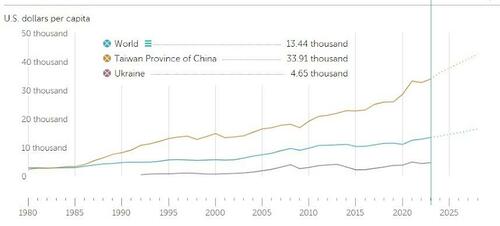In a bombshell new report, Financial Times has revealed that President Biden plans to formally ask Congress to use funds to arm Taiwan utilizing the supplemental budge for Ukraine.
The report states that the White House’s Office of Management and Budget “will include funding for Taiwan in the supplemental request as part of an effort to accelerate the provision of weapons, according to two people familiar with the plan.”
If approved by Congress, this would be a major milestone in Washington’s bolstering Taiwan’s defense, given the self-ruled island would for the first time ever receive American arms through what’s called “foreign military financing.”

It would also mark a first time use of the “presidential drawdown authority” for Taiwan, meaning the Pentagon would tap its own stockpiles which has long been used to supply Ukraine.
The FT report has come on the heels of last Friday’s newly announced White House aid package of up to $345 million for Taiwan.
China’s Taiwan Affairs Office issued another blistering condemnation of US military support to Taiwan, underscoring that Beijing’s efforts to unify the island to the mainland will continue undeterred.
“No matter how much of the ordinary people’s taxpayer money the … Taiwanese separatist forces spend, no matter how many U.S. weapons, it will not shake our resolve to solve the Taiwan problem,” Taiwan Affairs Office said, adding “…Or shake our firm will to realize the reunification of our motherland.”
Meanwhile, Nikkei Asia has observed in some fresh analysis that the Chinese PLA military has steadily increased and even sped up preparations to blockade Taiwan ever since the Pelosi visit. This has continued unabated, FT observes, writing:
China has greatly increased its conducting of military drills simulating the containment of Taiwan since then-U.S. House Speaker Nancy Pelosi visited the island a year ago. Nikkei analyzed the possibility of China’s invasion of Taiwan, using drone-taken images and views by experts.
Even the range of activities by the Chinese military around Taiwan has changed. Before Pelosi’s visit on Aug. 2 of last year, Chinese military planes and ships rarely moved around to the east of Taiwan. Instead, they primarily engaged in activities southwest of the island. Over the past year, they have become active in the Western Pacific, or the Philippine Sea, having Taiwan to the west.
Both of the large Chinese aircraft carriers–the Shandong, which was its first domestically developed aircraft carrier–and the Liaoning, have been spotted in waters near Taiwan, and are becoming more active in conducting war simulations, alarming Taipei further.
Looking at GDP and economic growth, one might ask the obvious: why does Taiwan need our constant taxpayer dollars on a continual basis (akin to Ukraine)?








